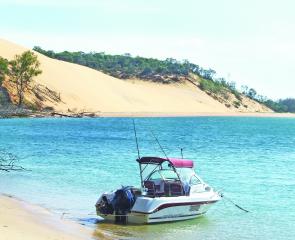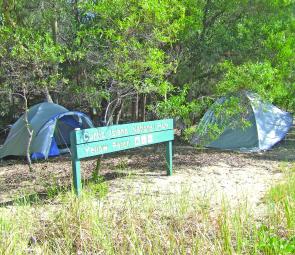.
When heaven was created, Gladstone must have been the prototype. It has lots of spectacular fishing/camping locations that will keep fishers and campers happy.
Yellow Patch is one of the best locations. It’s part of the Curtis Island National Park so a camping permit is required. For more information visit http://www.epa.qld.gov.au/ or contact Qld Parks and Wildlife Gladstone on (07) 4971 6500.
Yellow Patch can only be reached by boat and is around 25 miles from Gladstone. Yachties regularly use this as a stop over point as the bay is usually protected from all winds except strong northerlies. Boating day trippers and picnickers also frequent Yellow Patch as it’s an easy trip up the scenic coast of Curtis Island.
After rounding Cape Capricorn travel 1.5nm due west to Point A (GPS 23S29.566 and 151E12.598). From here you will have a complete view of Yellow Patch’s huge yellow sand hill.
Point A is in line with the channel between two large sand banks. The entrance to Yellow Patch is nothing compared to the bars in SEQ but caution is still necessary. It is best entered with tidal assistance and like all bars – check it out before you commit. If in doubt – don’t.
Unofficial red and green drums have been placed to mark the channel entrance and white drums mark the edges of the sand banks. However, you cannot always rely on those to be there.
From Point A take a bearing of approx. 1500 towards the beach. At Point B (23S30.000) take a bearing of about 1160 to run parallel to the coastline. Follow the beach line at depth until you find your own spot. Any further west of the sand hill is accessible only on high tides and usually only by smaller tinnies. I have seen tinnies head over to the mangrove edges of the island.
The beach runs the length of the small bay and shady trees make this a great place to camp. I prefer the location right at the National Park sign (Point C) as it has large flat areas and you can park your boat on the beach. Visitors can fish, swim or just sit and watch the world go by.
Sand flies and mozzies usually go all out during the summer nights here so bring some good protection.
Point D is also another good location where the beach slopes steeply into the water. Camping behind the trees is protected and sheltered with equally as good flat areas for tents or swags.
You need to be self sufficient while camping on Yellow Patch as you may be the only person on your patch of beach.
From the beach you only need to look into the water to choose your supper. Whiting and bream are prolific. But a word to the wise – your bait will have to be super fresh to get these well fed little blighters on the hook.
Yellow Patch is one huge yabby patch so don’t forget to throw in the pump when you visit. On this trip we only had frozen prawns and whiting would sniff them and screw up their noses. Nothing we did would entice them to bite, but schools of 30cm+ whiting would happily swim around our toes.
Just north of the yellow sand hill are clumps of rocks that reach into the channel. The drop-off here is about 8-10m. This is a different fishing environment with Moses perch, stripeys, trevally, fingermark and bream easily coming to the hook. Baitfish school up in the thousands here so wild splashing frenzies seem to go on everywhere around these rocks. You will also hook the occasional stingray and small shark as they are attracted to these frenzies.
There is nothing more enjoyable than camping on the beach with your boat – if you do it right! You can make it as easy or as difficult as you like. Here are my top five hints to make your boating/camping/fishing adventure easier and more enjoyable for everyone.
You only have two options: beach the boat or let it float. If you beach the boat, select a location that is free of bottom debris and either flat or gently sloping. If you allow the boat to float you must anchor and tie up well, allowing for strong tides. Always anchor up stern to beach.
I prefer to beach my boat overnight. I like to know it’s going to be there in the morning as I have seen boats drift away during the night.
Whether you float or beach the boat, you need to make sure the anchor is firmly set.
Go astern into the beach and from the bow, lower (not throw) the anchor.
Continue to go astern slowly allowing all the chain to lay flat, straight and tangle-free.
With the chain all out, tie off and continue to go astern slowly until the anchor beds well. The boat shouldn’t move when the anchor is properly bedded.
Release the bow anchor line; go astern all the way to the beach and then tie off.
Tie a stern line from the boat all the way to the beach. Tie off to a tree if possible or bury your second anchor into the beach.
I like to tie a rubber stinger to my bow line to take the pressure off the anchor – just in case the winds pick up during the night.
However you anchor your boat, you must know the tide chart. Tide tables rarely provide all the required information. On the local tide chart, find the time and the depth of water on your arrival and slide your line across to determine when (or if) you can leave. If you anchor up at 1:15pm your boat will be out of water all night with your earliest departure time at 9:45am the next day. You also have to be out before 1:45pm.
That sounds like a good plan if you’re camping overnight but not if you are only planning to picnic for the day. In this case you will need to keep moving the boat to deeper water with the outgoing tide.
Tidal information is available from lots of web sites but I use http://www.mobilegeographics.com:81 . You can also load this to your PDA.
Consider the trim when packing gear around your boat. Try to balance the load from bow to stern and port to starboard.
Keep all your access areas (anchor well, fire extinguisher, bait well) clutter free. Load the boat at home and walk around to see if you can do everything you plan on doing.
You can’t take too much water but freeze it in bottles to reduce your ice. Having food in vacuum packs and keeping them frozen also minimises ice demand.
Try taking dual purpose items. Your esky might make a great table for your camp stove. Storage boxes that stack make great dinner tables. Pack non-returning gear (food) in cardboard boxes that can be used to start your camp fire (if allowed)
Pack in lighter loads. It is a sorry sight watching some poor person lug heavy loads up and down the hot soft beach.
Seal all food containers to keep critters away from your tucker. Take a sealable bag/box/container in which to keep your rubbish and bring it home. Good quality light, waterproof sealable containers are worth every penny.
I hope these hints will help make your trip as enjoyable as the location.
Reads: 13722

Anchoring up at the beach in Yellow Patch at Point C. Check out the gently sloping location and the position of the bow and stern anchoring lines.

Bream of all sorts are caught from the rocks in the Yellow Patch channel including this blubberlip bream.

This campsite at Yellow Patch is at Point C on the map and has plenty of features to make it a top spot.




